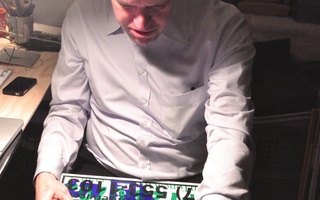By EVA M. DELAPPE
Contributing writer
Andy Warhol was a dangerous combination of magnetism, fame, and power. His strong persona, coupled with his mechanical, industrialized production of art, made it easy for individuals involved in Warhol’s studio-cum-entourage—the Factory—to slip through the cracks. In her debut documentary, Esther Robinson explores the involvement and the mysterious disappearance of her uncle, Danny Williams ’61. “A Walk into the Sea: Danny Williams and the Warhol Factory,” shown this past weekend at the Institute of Contemporary Art (ICA) with commentary from Robinson, investigates the much-examined Warhol clique from a personal, fresh perspective, exploring the inner machinations of the Factory. Weaving intimate interviews of aging Factory members with excerpts from Williams’ striking films, Robinson tells the story of a creative young man denied the approval of his dominating mother due to his homosexuality and betrayed by Warhol’s Machiavellian manipulation of the boy’s talent and love. Instead of expanding the idea of Andy Warhol as an icon, Robinson delves into the personal, human interactions that the Factory ultimately thrived on but which were often overshadowed by Warhol.
Williams spent time at Harvard, honing both his visual sensitivity as a member of The Harvard Crimson photography staff and—as Robinson speculates—his appreciation for drugs as a possible test subject in Dr. Timothy Leary’s psychedelic drug experiments. However, the issue of sexuality made it difficult for him to enjoy his Harvard experience.
“Danny was in his first or second year, really struggling and having a hard time being gay at Harvard,” Robinson says. As a result, he left school and decided to pursue a career in film.
Williams moved to New York City, where he became involved with the Factory and with Warhol himself. A filmmaker and electrician, Williams created much of the Exploding Plastic Inevitable Show, but despite Williams’ crucial involvement, this complex light show—which mimicked tripping on hallucinogenic drugs and accompanied a concert performed by The Velvet Underground and Nico—was attributed to Williams’ lover, Warhol.
“Imagine you’re in your 20s, the sexiest, youngest, most creative, most productive, and most vibrant you’ll ever be,” Robinson says. “You move to New York to make art. You’re at the Factory, at the center of everything. And from then on everything you create is ascribed to Andy. It’s an incredibly disfiguring experience.”
In the process of researching her uncle’s art and history, Robinson discovered that the Factory was plagued with a “sense of fighting and jockeying for position and status.” Interviews with Williams’s fellow Factory fixtures—John Cale of the Velvet Underground, Brigid Berlin, Paul Morrissey, Billy Name, and others—show the bitterness, gossip, and jealousy that characterized the inner workings of Williams’s world. Yet these interviews of elderly, solitary, forgetful “new-agers”—juxtaposed with the ephemeral, joyous images of them from Williams’s lovely original films—remind the audience that the Factory was very human, if only because it shows that idols also age.
“I wanted to show the inconsistency of the whole narrative of the time and to show people as people,” Robinson says, “not as icons.”
Despite her attempts at dispelling some of the mystery surrounding the Factory, the perplexing nature of Williams’s disappearance is never resolved. After a falling out with Warhol, a bewildered, drug-addled Williams returned home to Rockport, MA for dinner, only to disappear forever later that night.
Although Robinson reveals juicy tidbits about The Factory, she ultimately engages the audience through the film’s intrinsic intimacy. Excerpts from Williams’s compelling short films—which experiment with contrast and light, creating a unique visual rhythm by alternating slow-motion images of Warhol and crew with speedy second-long splashes of faces, lights, and darkness—compliment Robinson’s caring investigation of her family history. A 2007 winner of Best Documentary Film at the Berlin Film Festival and the New York Loves Film Award at the Tribeca Film Festival, “A Walk into the Sea: Danny Williams and the Warhol Factory” brings light to an artist whose history was until recently engulfed by, as Robinson puts it, “the giant Warhol myth.”
Read more in Arts
Leave the Leggings for Levi’s: Finding the Perfect FitRecommended Articles
-
For His 80th, Warhol Granted More Than His 15 MinutesAndy Warhol infamously said, “Everyone will be famous for 15 minutes.” By now Warhol has contradicted his own statement: his
-
15 Books in FM's Lamont-Worthy CollectionEach year, three lucky Harvard students cash in big—in the most unlikely of ways. The Visiting Committee Prize for Undergraduate ...
-
 CA$H for your HARGADON
CA$H for your HARGADON -
 Harvard Art Museums' Study Center Showcases Warhol Collection
Harvard Art Museums' Study Center Showcases Warhol Collection -
 Warhol's Next Fifteen Minutes
Warhol's Next Fifteen Minutes













